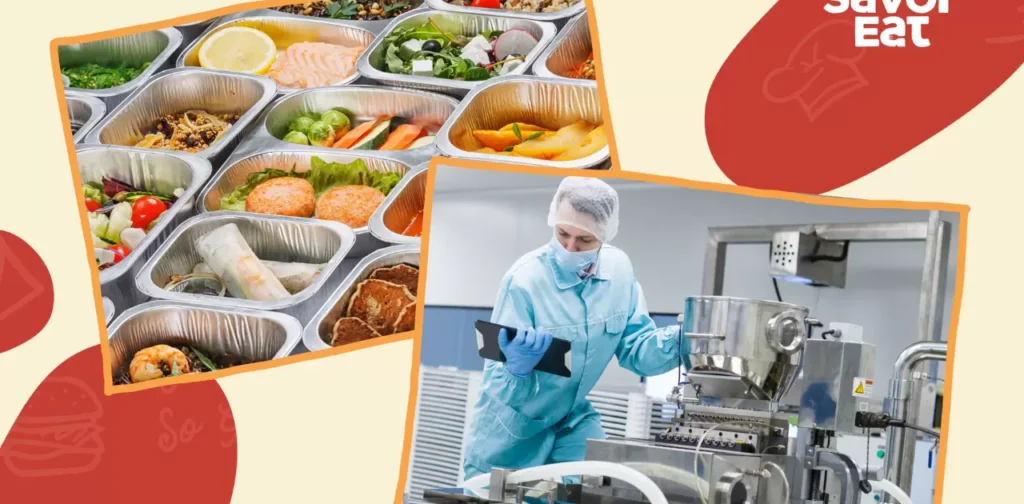In recent years, a distressing pattern has emerged an alarming surge in Listeria outbreaks associated with ready-to-eat (RTE) foods.
These outbreaks have raised serious concerns about the safety of RTE products and the challenges of preventing Listeria contamination throughout the intricate food production and distribution chain.
As consumers, we trust that the foods we purchase are safe for consumption, but the rise in Listeria outbreaks has shaken that confidence. It is crucial to address this food safety issue head-on to protect public health and restore trust in our food supply.
Complex Food Supply Chains: A Breeding Ground for Listeria
Modern food supply chains are intricate and interconnected, with RTE foods often passing through multiple stages of production, processing, and distribution before reaching consumers. Each step in this complex journey presents opportunities for Listeria contamination, from sourcing raw ingredients to final packaging and distribution.
Consider, for instance, a popular RTE product like pre-packaged salads. The lettuce and other vegetables may be sourced from various farms, processed at different facilities, and then assembled, packaged, and distributed through multiple channels before landing on grocery store shelves. A lapse in food safety protocols at any point along this intricate supply chain could lead to Listeria contamination, putting consumers at risk.
The globalization of food production and distribution has further exacerbated the issue. RTE foods can now be sourced from multiple suppliers and locations around the world, making traceability and recall efforts more challenging in the event of an outbreak.
Also read this: Afrikana Menu Prices United Kingdom Updated June 2024
High-Risk RTE Food Categories: A Perfect Breeding Ground

Certain RTE food categories are particularly vulnerable to Listeria contamination due to their composition, processing methods, and storage conditions. These high-risk foods include:
- Deli meats: Processed meats like ham, turkey, and roast beef are susceptible to Listeria growth if not properly refrigerated or handled.
- Soft cheeses: Unpasteurized soft cheeses, such as brie and camembert, can harbor Listeria bacteria.
- Smoked seafood: Smoked fish, such as salmon and trout, can be a breeding ground for Listeria if not properly cured or stored.
- Pre-packaged salads: Leafy greens and other fresh produce, when pre-cut and packaged, are vulnerable to Listeria contamination if not kept at appropriate temperatures.
RTE foods that undergo minimal processing or require refrigeration for storage are especially at risk if proper temperature control and sanitation practices are not maintained throughout the production and distribution chain.
The Resilient Listeria Monocytogenes: A Formidable Foe
Listeria monocytogenes, the bacteria responsible for listeriosis, is notoriously resilient and difficult to eradicate. Unlike many other foodborne pathogens, Listeria can thrive in a wide range of environments, including refrigerated conditions and low-moisture foods. Its ability to survive and grow in these conditions makes it a formidable foe in the battle against food contamination.
Even after rigorous sanitation efforts, Listeria can persist in food processing facilities, equipment, and surfaces, leading to recurring outbreaks. This tenacity poses a significant challenge for food manufacturers and regulatory agencies tasked with ensuring the safety of RTE foods.
Vulnerable Populations at Risk: Pregnant Women, Newborns, and Immunocompromised Individuals
While Listeria infections can be unpleasant for healthy individuals, causing symptoms like fever, muscle aches, and gastrointestinal distress, certain populations are at a much higher risk of severe complications and even death from listeriosis.
Pregnant women are particularly vulnerable, as Listeria infection during pregnancy can lead to miscarriage, stillbirth, premature delivery, or life-threatening infections in newborns. In fact, a tragic outbreak linked to contaminated cantaloupe in 2011 resulted in the deaths of 33 people, including several newborns.
Individuals with weakened immune systems, such as those undergoing cancer treatment, organ transplant recipients, and the elderly, are also at increased risk of severe illness from Listeria. Even low levels of contamination can lead to severe infections in these vulnerable groups.
Regulatory Challenges: Keeping Up with the Evolving Threat

Regulating RTE foods and ensuring compliance with food safety standards is a significant challenge for government agencies and food industry stakeholders. The complexity of the food supply chain coupled with the dynamic nature of foodborne pathogens like Listeria necessitates robust regulatory frameworks surveillance systems and enforcement mechanisms.
Regulatory bodies must collaborate closely with food producers, processors, and retailers to implement preventive controls, conduct risk assessments, and monitor compliance with food safety policies. The ever-evolving nature of the threat and the emergence of new food production and distribution methods can strain existing regulatory frameworks.
Ensuring food safety in a globalized market adds another layer of complexity, as regulatory agencies must coordinate with international partners to harmonize standards and facilitate information sharing during outbreaks.
Prevention Strategies: A Multifaceted Approach
Preventing Listeria outbreaks in RTE foods requires a multifaceted approach that addresses risk factors across the entire food production and distribution chain. Some key prevention strategies include:
- Implementing stringent sanitation practices: Food processing facilities must maintain strict sanitation protocols, including thorough cleaning and disinfection of equipment, surfaces and environments, to minimize the risk of Listeria contamination.
- Monitoring and controlling environmental conditions: Temperature, humidity, and other environmental factors must be closely monitored and controlled throughout the production and storage processes to prevent Listeria growth.
- Enhancing traceability and recall systems: Robust traceability systems must be in place to quickly identify and remove contaminated RTE foods from the market in the event of an outbreak. Efficient recall procedures are crucial to minimize the risk to consumers.
- Educating food handlers and consumers: Providing comprehensive training to food handlers on proper food handling, storage, and preparation practices is essential. Consumers must also be educated on safe food handling practices, particularly for high-risk populations.
- Conducting regular testing and monitoring: Regular testing and monitoring of RTE foods for Listeria contamination should be a standard practice throughout the supply chain. Early detection can prevent outbreaks and protect public health.
- Investing in research and innovation: Continued research into Listeria behavior, improved detection methods, and innovative food safety technologies can help stay ahead of the evolving threat and develop more effective prevention strategies.
By implementing a comprehensive, multi-layered approach involving all stakeholders, from food producers to regulatory agencies and consumers, the risk of Listeria outbreaks in RTE foods can be significantly mitigated.
Also read this: Baba Foundation Menu Prices United Kingdom Updated June 2024
Safeguarding Our Food Supply

The alarming rise in Listeria outbreaks linked to RTE foods serves as a wake-up call for the food industry and regulatory agencies. It underscores the need for vigilance, collaboration, and proactive measures to ensure the safety and integrity of our food supply.
While the challenges posed by complex supply chains, high-risk food categories, and the resilience of Listeria monocytogenes are formidable, they are not insurmountable. By implementing comprehensive prevention strategies, investing in research and innovation, and fostering cooperation among all stakeholders, we can protect public health and restore consumer confidence in the safety of RTE foods.
Safeguarding our food supply is not just a matter of regulatory compliance; it is a moral imperative. We owe it to vulnerable populations, such as pregnant women, newborns, and those with weakened immune systems, to prioritize food safety and take every possible measure to prevent Listeria outbreaks.
The rise in Listeria outbreaks serves as a rallying cry for the food industry and regulatory agencies to redouble their efforts, embrace innovation, and work together to create a safer, more resilient food system that prioritizes public health above all else.
Frequently Asked Questions
What is Listeria monocytogenes, and why is it so dangerous?
Listeria monocytogenes is a type of bacteria that can cause listeriosis, a serious foodborne illness. It is particularly dangerous because it can survive and grow in refrigerated environments and low-moisture foods, making it difficult to control in RTE food production. Listeria infection can lead to severe complications, such as miscarriage, stillbirth, and life-threatening infections in vulnerable populations like pregnant women, newborns, and individuals with weakened immune systems.
Which RTE foods are considered high-risk for Listeria contamination?
Some of the high-risk RTE food categories for Listeria contamination include:
- Deli meats (ham, turkey, roast beef)
- Soft cheeses (brie, camembert, queso fresco)
- Smoked seafood (smoked salmon, trout)
- Pre-packaged salads and fresh produce
- Unpasteurized milk and dairy products
These foods are vulnerable due to factors like minimal processing, refrigerated storage requirements, and potential for cross-contamination during handling and preparation.
What can consumers do to reduce their risk of Listeria infection from RTE foods?
Consumers, especially those in high-risk groups like pregnant women and immunocompromised individuals, can take the following steps to reduce their risk:
- Avoid consuming high-risk RTE foods like deli meats, soft cheeses, and unpasteurized dairy products.
- Thoroughly reheat RTE foods until steaming hot before consumption.
- Refrigerate RTE foods promptly after purchase and consumption.
- Clean refrigerators, kitchen surfaces, and utensils regularly to prevent cross-contamination.
- Wash hands thoroughly before handling RTE foods.
- Check for recalls and discard any potentially contaminated products.
What role do regulatory agencies play in preventing Listeria outbreaks?
Regulatory agencies like the Food and Drug Administration (FDA) and the United States Department of Agriculture (USDA) play a crucial role in preventing Listeria outbreaks by:
- Establishing and enforcing food safety regulations and standards for RTE food production and handling.
- Conducting inspections and audits of food processing facilities to ensure compliance with safety protocols.
- Monitoring and investigating foodborne illness outbreaks, issuing recalls, and taking enforcement actions when necessary.
- Collaborating with food producers, researchers, and international partners to develop and implement effective prevention strategies.
- Educating consumers and providing guidance on safe food handling practices.
Regulatory oversight and enforcement are essential components of a comprehensive approach to mitigating the risk of Listeria outbreaks.
How can the food industry improve its efforts to prevent Listeria contamination?
The food industry can take several steps to enhance their efforts in preventing Listeria contamination, including:
- Implementing robust food safety management systems (FSMS) and Hazard Analysis and Critical Control Points (HACCP) plans tailored to RTE food production.
- Investing in advanced sanitation technologies, such as antimicrobial surface treatments and environmental monitoring systems.
- Conducting regular environmental and product testing for Listeria and other pathogens.
- Providing comprehensive training and education for food handlers on proper sanitation, hygiene, and food handling practices.
- Collaborating with regulatory agencies, academic institutions, and industry partners to share best practices and stay informed about the latest developments in food safety.
- Adopting traceability and recall systems that allow for rapid identification and removal of contaminated products from the market.
By prioritizing food safety and continuously improving prevention strategies, the food industry can play a vital role in reducing the risk of Listeria outbreaks and protecting public health.
Conclusion
The alarming rise in Listeria outbreaks linked to ready-to-eat foods is a sobering reminder of the challenges we face in ensuring food safety. While complex supply chains, high-risk food categories, and the resilience of Listeria monocytogenes present formidable obstacles, a multifaceted approach can mitigate the risks.
Stringent sanitation protocols, environmental monitoring, enhanced traceability, consumer education, and regular testing are all crucial components of an effective prevention strategy. Collaboration between food producers, regulatory bodies, and consumers is paramount in this endeavor. Continued investment in research and innovation will also be vital to staying ahead of this evolving threat.
Safeguarding our food supply is not just a matter of regulatory compliance but a moral imperative to protect public health, especially for vulnerable populations. By prioritizing food safety and working together. we can overcome the challenge of Listeria outbreaks and restore confidence in the safety of ready-to-eat foods.

Ethan Henry with 8 years of expertise in bamboo, excels in sustainable design, construction and product development. His passion for eco-friendly solutions has driven innovative advancements in bamboo-based industries.











